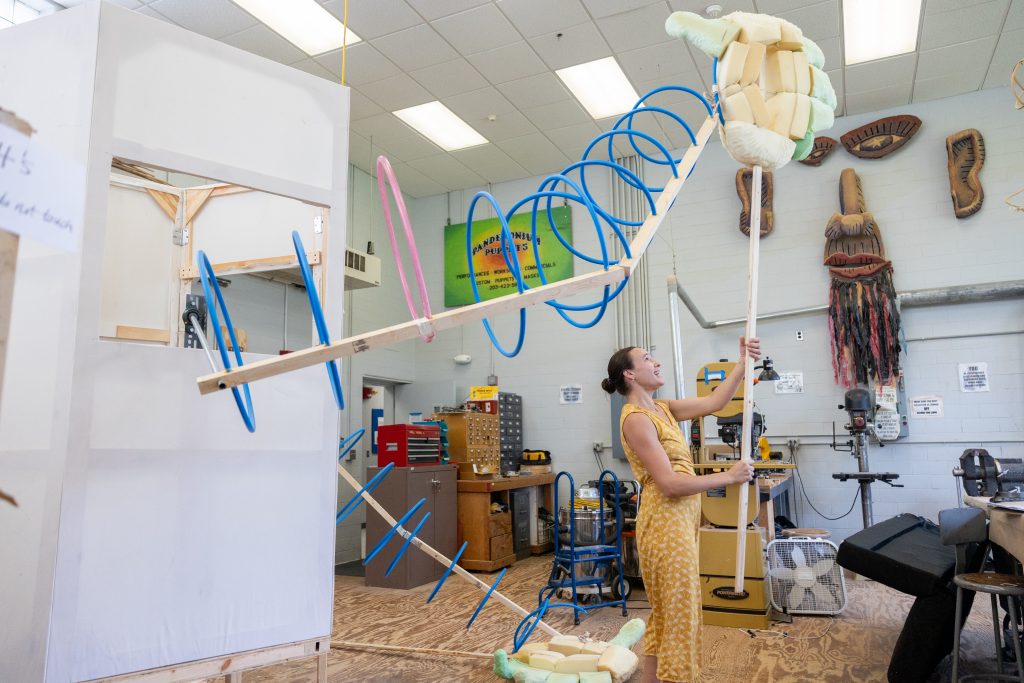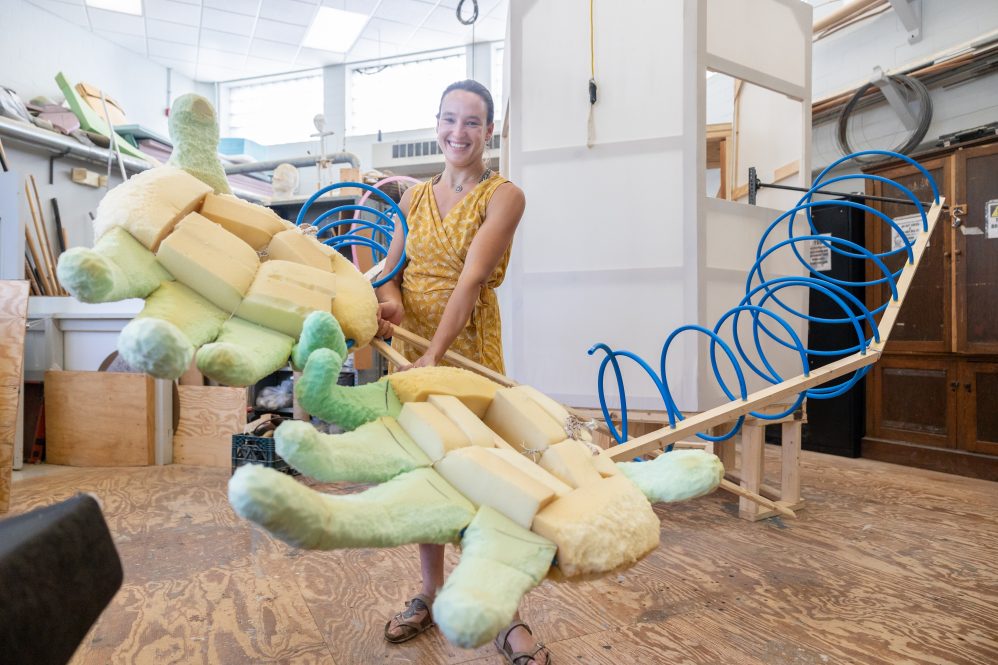Some might call Joanie Papillon a triple threat – she can act, dance, and sing. But when someone calls her multidisciplinary – that is, engineer, sculptor, producer, and entertainer – she jokes the compliment is good for her ego.
It’s also good for the resume of a puppetry professional who’s spent the summer studying OSHA regulations to properly design the framing for a 15-foot-tall jack-in-the-box-style puppet that’s joined together using door hinges, so pulling out or putting in the pins allows for quick take down or assembly.
Or one who sculpted the face of that puppet in modeling clay over a small, inverted sand pail and plans to use plastic wrap and masking tape to copy its contours, then make cuts in the plastic to lay it flat and project the image onto large foam sheets to be cut, sculpted, and formed into a recreation of that small sculpture, only 12 times bigger.
“Puppeteers talk about the concept of full agency in puppetry,” Papillon ’24 (SFA) says. “A lot of times you’re the one writing the script, designing the puppets, building the sets, and performing the show. With puppetry production, you’re doing more than giving a written script to an actor or director who can either make it better or mess it up. In puppetry, oftentimes, you have full artistic control and that’s why I love it.”
From start to finish, Papillon is in the process of bringing to life her original play “Taurus” thanks to a Summer Undergraduate Research Fund (SURF) grant to build the 15-foot-tall Harry the Giant, a UConn IDEA Grant award to create the other character puppets, and D Series funding from the Department of Dramatic Arts in the School of Fine Arts to bring the production to the stage next spring.
“I’m really grateful to have the whole experience here at UConn where I have so much support from faculty and colleagues,” she says. “This is the height of my student career here, but it’s also something that will help me bounce into the professional world after my graduation next May.”
A way to act, dance, and sing
Papillon is an older BFA student, having grown up in Montreal and obtaining a post-secondary degree in ballet before attending the Canadian College of Performing Arts in British Columbia where she added singing and acting to her repertoire.
That’s when she developed a love for the multidisciplinary aspect of performance, only musical theater didn’t do enough to blend all three, she says, “I found it was more like, ‘Now we’re going to dance, and then I’m going to sing. Next, everything will stop, and we’ll have this scene.’ That didn’t really work for me.”
Her first full-time job out of school was with Puppets for Peace, a Canadian organization that stages giant, mostly outdoor puppetry performances. She says she often would wear a puppet – a full body suit that to the casual observer might look more like a school mascot costume but really is considered a puppet, especially when someone gives it life.
“I discovered then that puppetry was a medium that intrinsically involves all the disciplines because you need to have knowledge of movement and how movement creates story in order to bring the puppets to life,” she says. “Music and text fill the space around that movement, combining the three. That’s when I got hooked on puppetry. Still, I wanted to develop a language that emphasized even more my skills in dance and song, so I moved back to Montreal and launched a nonprofit, Meute Monde, in 2018.”
Papillon and her troupe toured schools and day cares to tell stories to children using puppets, until the pandemic and most places shuttered for quarantine. She thought the opportune time had come for her to get more training and sought a puppet-centric education at UConn.
Because her previous post-secondary education never officially earned her a bachelor’s degree, Papillon is finishing her undergraduate work now, although has been able to take some higher-level, graduate classes given her background.
“I still feel like I’m getting what I want,” she says. “I was mostly attracted to UConn because there would be people from all over the world in this program. The networking that has been happening both with the teachers and the students has been amazing. Getting to know them has been a rich experience because I only knew puppetry from my personal research. I didn’t know how old an art form it is.”
‘Taurus’: Three stories in one
The story of “Taurus” took shape over two semesters last year, starting as a project in her Plays for Puppet Theatre class that asked students to develop a story of their own. Drawing inspiration from the play, “Cathay: Three Tales of China” by Ping Chong – who visited UConn in January and who Papillon had the chance to work with – Papillon wrote “Taurus” as three stories in one.
In the first part, she’ll use shadow puppets to tell the story of the Taurus constellation in which Zeus, disguised as a white bull, abducts princess Europa.

The second section features Harry the Giant in a fantasy world in which Harry is outgrowing his house, literally expanding onstage during the performance as his 12-foot arms grow to extend across the performance space.
The third story happens in a university setting and puts live actors, who’ll be cast early next year, in a realistic world, discussing mythology and a story one of them is writing.
“The whole thing is about love and questions of nature or nurture and how power dynamics come up in loving relationships,” Papillon says. “The Giant is a metaphor for growing too fast or outgrowing our own self. As an artist, I’m someone who lives emotions, and I wanted to channel that into a story that was universal.”
The result, though, is a play that looks much different from that first draft in class, she admits, and one that, after rehearsals, likely will look even more different than today.
Papillon compares the artistic process to making a vat of soup, a metaphor she learned from teacher Kate Brehm: Add ingredients slowly, stir to combine, then taste to tell if more seasoning is needed before adding a few more ingredients, maybe some unexpected ones, and tasting along the way.
“As I was writing the text, I started doing the sketches because design is truly part of the story telling,” she says. “I wanted to see the Giant break through the roof of the house, so I sketched what that would look like and doing that changed the whole set. It helped me start to see the world that was going to bring the three stories together and how we could tell those stories as clear, distinct chapters, but all in the same intimate space.”
Bringing sketches to life means sculpting foam, bending PVC pipe, and finding a use for old curtains that might just be painted to look like the puppets’ skin. Then there’s figuring out rigging, building platforms, and configuring shoulder and elbow joints on gigantic arms to move somewhat naturally.
Harry will have one puppeteer assigned to each arm and another to his head. A fourth person might be needed for his voice, if the one working his head can’t manage both tasks, she says.
“Giant puppetry has a lot of engineering attached to it. Last semester, I learned the engineering computer program Fusion 360 to model the bearings and rigs and see how they would work together. Working on that first 12-foot-tall puppet was such a learning curve. This process was much smoother because I spent so much time preparing, drawing, redrawing, and talking about the Giant before I got into the actual building.”
Back in Canada, Papillon has a small home renovation business, Peinture Papillon, which gives her the benefit of utilizing practical carpentry skills in the field and later refining them in the puppetry workshop. She might have an edge when it comes to recognizing that removing the pin on a door hinge could make for quick disassembly of an object.
“I want to keep promoting ‘Taurus’ and hope it has a life after UConn. It’s my first piece for adult audiences since what I do in Canada with my puppet company is for kids 12 and under. That’s why I designed it for easy travel,” she says, praising UConn’s program for helping her to better integrate engineering, design, and production skills into her triple-threat repertoire.
“Puppetry is a medium that’s very easy to tour with because it has a large syntax, especially in a work like ‘Taurus,’” she adds. “I really want to keep this show alive. A few teachers have suggested I translate it into French. I wrote it in English, which isn’t my first language, and got very close to the language so I would need to find a collaborator in Quebec to translate it.”
Then she can add wordsmith to the resume skills list.
“Taurus” will be performed March 28-30, 2024, in the Studio Theatre in the Fine Arts Complex on campus. Tickets will be available next year.



